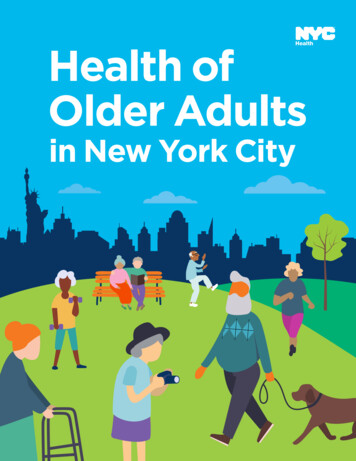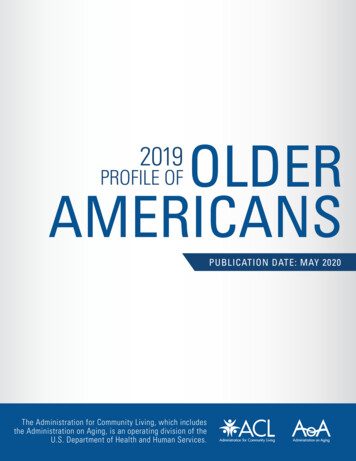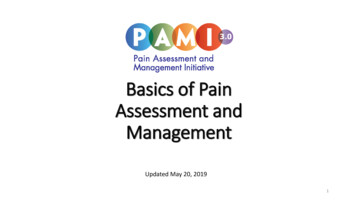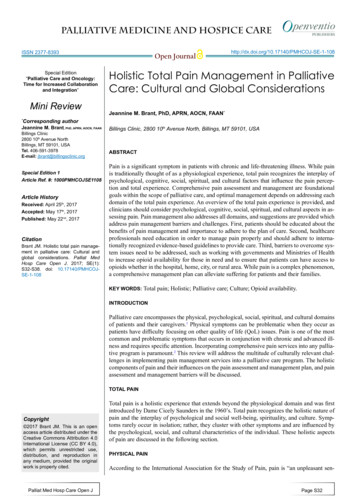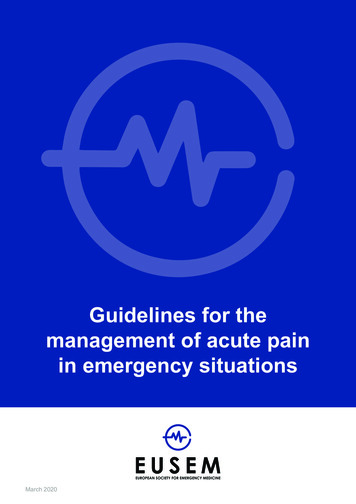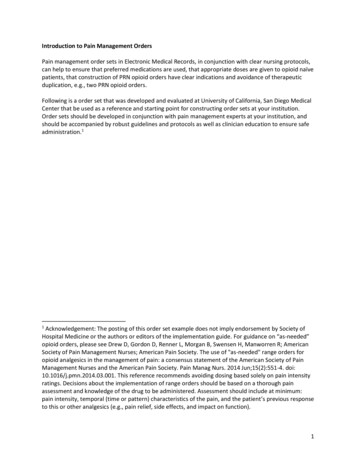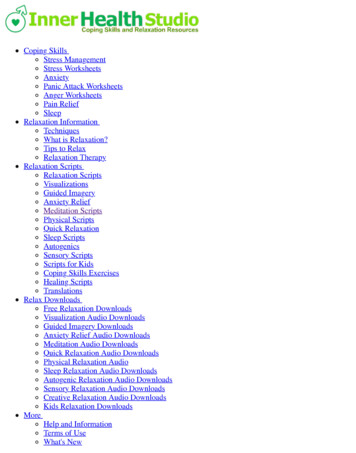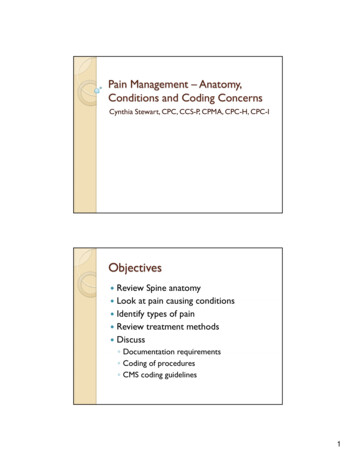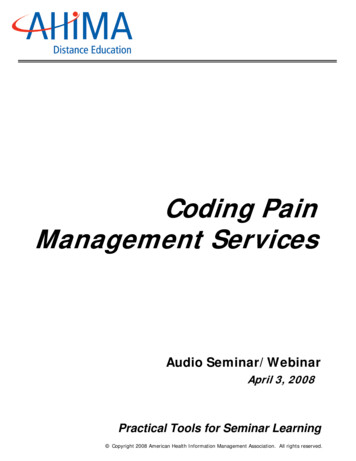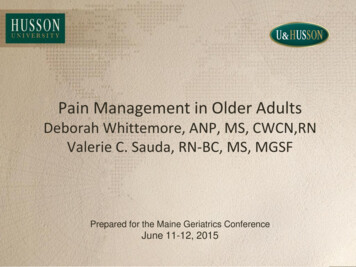
Transcription
Pain Management in Older AdultsDeborah Whittemore, ANP, MS, CWCN,RNValerie C. Sauda, RN-BC, MS, MGSFPrepared for the Maine Geriatrics ConferenceJune 11-12, 2015
Disclosure The presenters DO NOT have an interest in selling a technology, program, product, and/orservice to CME/CE professionalsDeborah Whittemore and Valerie Sauda have nothing to disclose with regard to commercialrelationships.The content of this presentation does not relate to any product of commercial interest.Therefore, there are no relevant financial relationships to disclose.
Learning Outcomes1. Identify assessment tools/resources to assess chronic, acute, andend of life pain in older adults.2. Identify trends in use of pain medications in older adults.3. Identify non-pharmacological pain management concepts inmanaging pain in older adults.
What is pain?“Pain is defined as the physical feeling caused by disease, injury, or something that hurtsthe body mental or emotional suffering : sadness caused by some emotional ormental problem someone or something that causes trouble or makes you feel annoyedor angry”Retrieved April 20, 2015 from http://www.merriam-webster.com/dictionary/pain
Nursing process andpain managementPain can be: Physical Psychological/EmotionalNursing needs to EFFECTIVELY use nursing process toidentify and manage pain:1.2.3.4.5.AssessDiagnosePlanActEvaluate
Assessment of painKey principles in the assessment ofpain include: Intensity/severityPain relief measuresImpact on functionImprovement in pain intensity
Choosing a pain scaleIdentify best scale for use:Based on cognitive anddevelopmental level, acute vs.chronic, quality of life painlevels, and/or potential foraddiction
Choosing a pain scaleIdentify best scale for use: WILDA pain assessment guide Wong-Baker Verbal scale Analog scale Pain scale for person with dementia Pain scales for person withsubstance abuse
WILDA pain assessment Words to describe pain (aching, throbbing,crampy,shooting, sharp, etc.) Intensity (1-10) (What is your pain now?) Location (Where is your pain?) Duration (Is pain always there? Does pain comeand go(breakthrough)?) Aggravating/Alleviating Factors (What makes painbetter? What makes pain worse?)
Wong-Baker FACES scale Originally developed for pediatrics Has use in older adult population Tip: Not to be used by just looking at older adult’sface and recording facial expression, ask the olderadult how they feel insideRetrieved tent.aspx?ItemNumber 1519
Verbal/analog scalesVery common in all healthcare settings:Analog scale 0-10 scale (0 being no pain and 10 isthe worst possible pain)Verbal descriptor pain scale no pain, mild,moderate, severe, pain as bad as it could beMay not be effective in assessing older adult pain
Pain scale for person with dementiaLooks at the following: Breathing, negativevocalization, facial expression, body languageFind tool ry this d2.pdf
Pain assessment for people withsubstance abuse history There are evidence based tools developed to help identifypeople who are at risk for substance abuse Personal values and judgment are of significant nursingconsideration in working with people with substance abusehistories Screener and Opioid Assessment for Patients with Pain- Revised(SOAPP -R) Current Opioid Misuse Measure (COMM)
Chronic pain assessment American Chronic Pain Associationhttp://www.theacpa.org/ Multiple tools to help measure impact ofpain: Quality of Life Arthritis/fibromyalgia painmonitoring Pain logs
Pain assessment for people withsubstance abuse history There are evidence based tools developed to help identifypeople who are at risk for substance abuse Personal values and judgment are of significant nursingconsideration in working with people with substance abusehistories Screener and Opioid Assessment for Patients with Pain- Revised(SOAPP -R) Current Opioid Misuse Measure (COMM)
Scheduling of nursing assessments At each change in shift At each time a nursing action to relieve pain istaken Pre- and post-administration of pain medications When an unstable or inconsistent pain issue occurs(like a fall or acute injury)
Acting on pain Administration of medications,particularly opioids/narcotics has oftenbeen first line of defense. Suggest use of non-pharmacologicalinterventions in addition to opioid usedepending on type of pain
Administration of opioidsIdentify your own myths and beliefsReview medication side effects and use ifunsureStart low, go slowEnsure physical safety of medications throughfollowing policy/procedures
Administration of opioids Rely on objective assessment data Encourage scheduled pain medicationadministration Be vigilant about process-complete allsteps during the administrationimmediately document
Administration of opioids Monitor for side effects, assess for pain relief Communicate, communicate, communicatewith:-Resident-Primary Care provider/pain managementteam-Family or caregivers-Healthcare team members
To improve pain management nursingsystems: Pain rounds Pain interprofessional team meetings Use of pain management/palliative careconsultants
Pain in Older Adults 50% of community dwelling are affected by pain 80% of nursing home residents are affected Treatment needs to be focused on improving function morethan reducing pain Cognitive function and mobility/balance must be assessed aspart of pain management Most common misdiagnosed conditions include myofascialpain syndrome, chronic low back pain, lumbar spinal stenosis,and fibromyalgia syndrome. (Up to Date.com 11/014)
Nonsteroidal Anti-inflammatory DrugsUse Only 1-2 WeeksNaproxen sodium220mg BIDLess CV toxicityIbuprofen200mg TIDShort half lifeAvoid use with low doseaspirinCelecoxib100mg dailyReduction in GI toxicityCV risk is higherNo effect on plateletfunctioningMay need to continuelow dose aspirin with PPIUse of proton pump inhibitor or misoprostol reduces but does not eliminate GI riskSystemic corticosteroids, anticoagulants, antiplatelet drugs increase riskRisks include GI. cardiac, and renalRisks to kidney are lessened by avoiding dehydration and concomitant use of ACE Inhibitors and diuretics
What About Acetaminophen? Less significant anti-inflammatory properties Less effective for chronic pain than NSAID’s(The Lancet 2014no better than placebo for back pain) Maximum dose of 3GM in 24 hours 65 and up Less than 2GM in frail elderly and over 80 Component in many OTC medications FDA now encouraging development of single entity opioidssuch as Hysingla(oxycodone bitartrate)
Topical NSAID’sDiclofenac topical gel3-4 times dailyUseful for Rx of OA ofsuperficial jointsDiclofenac topical patchOne patch twice dailyIn combination withacetaminophen/TramadolDiclofenac topicalsolution2 -4 times dailyMinimal systemicabsorptionDiclofenac topical spray4 sprays up to 3 timesdailyLocal skin irritationModerately effective: Useful in combination with systemic therapies for reducing medicationload and side effects and potentially useful for adults with localized pain.Limitations of topical NSAID’s include cost, erratic local absorption, variable depth of penetration,inaccuracy of dosing, and frequent applications.Topical preparations are meant to penetrate the skin and tissue but not enter the plasma.Opioids and corticosteroid injections provide more pain relief but topical NSAID’s more effective inimproving function and stiffness in hip and knee osteoarthritis.
Opioid Analgesics There is no evidence that long term opioid therapyproduces long lasting benefits for individuals withchronic pain Only considered in moderate to severe pain Around the clock dosing for frequent or continuous pain Breakthrough pain must be anticipated Opioid adverse effects must be anticipated Potentially serious opioid abuse is not rare Must assess balance in elderly prior to initiating Decrease dose by 50% to start
Tramadol and Tapentadol Synthetic opioids with combined mechanisms of action By acting on U-opioid receptors and inhibiting reuptake ofnorepinephrine. Tramadol also blocks reuptake of serotonin Used as a step up from acetaminophen prior to more potentopioid analgesics Fewer serious adverse effects Respiratory depression rare Caution with seizures and serotonin syndrome with SSRI’s(Tramadol) 5-15% no response with Tramadol due to poormetabolism(CYP2D6 enzyme) Tapentadol only FDA approved drug for neuropathy( schedule II)
Recommended Opioids Morphine-avoid in renal dysfunction Oxycodone-good choice due to short half life and no toxicmetabolites Buprenorphine(Suboxone) Patch- is partial agonist/antagonist Decreased nausea, vomiting, constipation, respiratory depressionLarge study demonstrated 80% good to very good pain reliefLess addiction potential, euphoria, and withdrawal effectsSafe with renal impairment Hydromorphone- use short-acting formulation for breakthrough pain Fentanyl Patch- short acting and transdermal patch(not inopiate naïve)
Drugs to Avoid Muscle relaxants due to increased dizziness, sedation andanticholinergic effects(Baclofen, cyclobenzaprine, methocarbamol) Methadone- due to variable pharmacodynamics andpharmacokinetics and difficulty dosing. Increased risk ofaccumulation, overdose, and prolongation of QT interval Codeine- weak analgesic which is metabolized to morphine.Increased nausea and constipation. Ineffective in many patients dueto genetic CYP2D6 metabolic status Meperidine- long half life and toxic metabolites Limited evidence for efficacy of anticonvulsants and antidepressantsand significant potential for adverse events
For further information: Deborah Whittemore whittemored@husson.edu Office telephone 207-941-7189 Valerie Sauda, saudav@husson.edu Office Telephone 207-941-7036
part of pain management Most common misdiagnosed conditions include myofascial pain syndrome, chronic low back pain, lumbar spinal stenosis, and fibromyalgia syndrome. (Up to Date.com 11/014) Nonsteroidal Anti-inflammatory Drugs Use Only 1-2 Weeks Naproxen sodium 220mg BID Less CV toxicity

